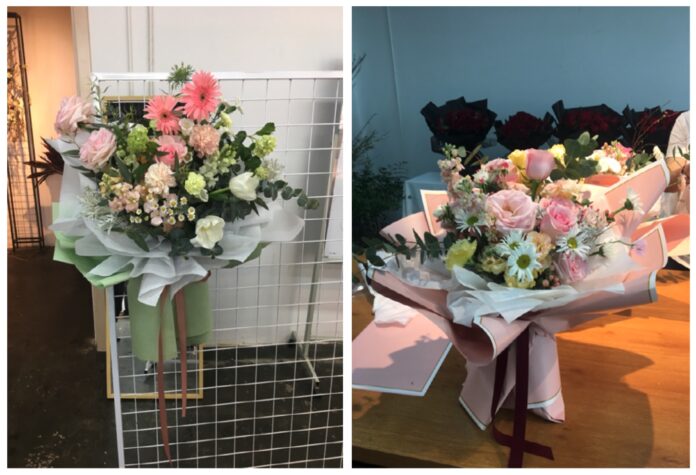Article begins
We often speak of flowers as emblems of natural beauty, as if their allure springs spontaneously from the earth itself. But when Hong received her carton of flowers on a sweltering summer day, she confronted a different reality. The severely dehydrated and partially damaged blooms demanded immediate intervention: ruined leaves trimmed, bruised petals picked off, dried stems rehydrated, room temperature carefully adjusted, and more. And yet, for reasons we could only speculate, the flowers continued to wither by the next morning. After a few attempts as such, Hong ultimately abandoned her pursuit of floristry, bothered by the unrelenting commitment to care that the beauty-making of flowers demands.
Credit:
Rui Sun

A newly arrived bouquet arranged in a domestic environment. The drooping stems show it is on the verge of dehydration.
Hong’s failed intervention is an example of the meticulous care required in nurturing the beauty of flowers. In fact, from field to vase, the Chinese floral industry is labor intensive. Producers prune bushes, cut away malformed branches, trim foot leaves, and sort flowers by variety and quality. Intermediaries revive dehydrated blooms, remove bruised petals, discard unsavable stems, and monitor temperature and humidity to preserve freshness. Attentive consumers would devote time and patience to prolong the vase life of flowers by constantly changing water and replacing the prematurely withered blooms. This repetitive yet essential labor is a craft of cultivation, selection, and preservation through which human standards of beauty are actively imposed on natural forms.
Credit:
Rui Sun

Workers in a flower trading company were sorting the roses by trimming the foot leaves (front) and checking on the petals for bruises (back).
Flower cultivation requires a form of responsive caretaking. In this light, growers become intimate observers of their plants, detecting threats invisible to untrained eyes: pest eggs hidden beneath leaves, early signs of disease, and subtle indicators of malnutrition. Besides, for small-scale growers who rely more on experience than technology, responsive caretaking involves embodied efforts. Gowers would visit their floral crops during different parts of the day to “feel” the environment. If growers feel cold in the greenhouse, it is time to heat it, as coldness would retard the growth of plants. If growers feel breathless in the greenhouse, the flowers need air too. Through an embodied feeling of perception, growers accumulate the care-based knowledge of cultivation.
Credit:
Rui Sun

A rose grower (left) and a salesman of pesticide and fertilizer were checking on pest eggs hidden beneath leaves.
The lack of care thereof could be damaging to both the dealers and flowers. During packing and transportation, careless handling exacerbates the withering of flowers, causing broken stems, bruised petals, and rotten leaves. For instance, flowers are kept dry in a sealed carton, to avoid fermentation which is induced by microbes attached to the plants and facilitated by the combination of high moisure and warm temperature. What a careful dealer could do before packing is to shake off excess water drops from the plants to reduce humidity. A flower trader only learned this after a few conflicts between him and his clients who accused him of sending them smelly flowers. As much as intensive care brings out the fragrance of flowers, insufficient care leads to the opposite.
Credit:
Rui Sun

Broken-off rose stems caused by careless handing during distribution.
Credit:
Rui Sun

Flowers laid out on the ground for packing into the carton.
Finally, when flowers arrive at the florist’s shop, the care to transform natural beauty into cultural artifact is carried out through precise physical techniques. To arrange a hand-tied bouquet, the skill called a “good clench” is the key to differentiate the beauty of flowers into hierarchies. A good clench should balance firmness and delicacy. The thumb and index finger form one group, and the middle, ring, and pinky fingers form the other. These two groups alternate between loose and tight to fix the knot of the bundle while leaving space for interweaving more blooms to enrich the arrangement. Much practice is needed to master this craft of arranging. It probably makes little difference to the untrained eye whether a floral arrangement has achieved the desired aesthetic effect. And yet, florists dedicate countless hours to refine their techniques, hoping to achieve beauty not in a general sense, but in its manmade, ideal forms. The craft of care in this final stage of beauty-making illuminates a complete domestication of flowers.
Credit:
Rui Sun

In a florist training session, the instructor was demonstrating a “good clench” for the arrangement of hand-tied red-rose bouquet.
Credit:
Rui Sun

A comparison of two hand-tied bouquets arranged with similar floral materials. At the connoisseur level, the bouquet on the right is appreciated as “exuding an effortless sense of fluffiness,” thus considered as more beautiful than the one on the left which is critiqued as “huddled together.”
This exploration of flowers—creatures we often take as symbols of pure, natural beauty—reveals something profound about human aesthetic experience. What we perceive as natural beauty is often the product of an intricate choreography of care. Care, in this interspecies relationship, shows itself as everyday practices of craft, a series of skilled interventions to tame nature to satisfy the insatiable human appetite.

